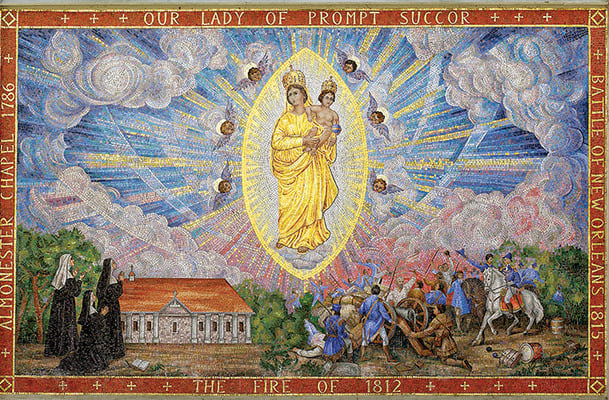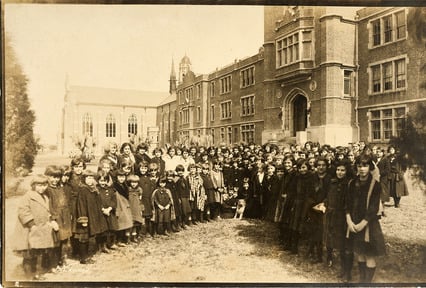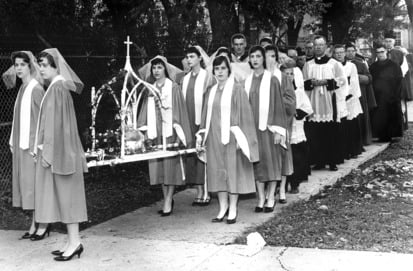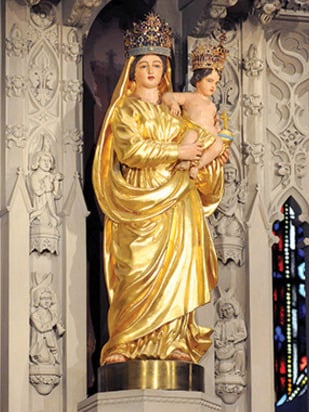
A platform that encourages healthy conversation, spiritual support, growth and fellowship

NOLACatholic Parenting Podcast
A natural progression of our weekly column in the Clarion Herald and blog

The best in Catholic news and inspiration - wherever you are!
New WYES documentary sheds light on National Shrine of Our Lady of Prompt Succor
-

Above: A mural on the back wall of the Old Ursuline Convent on Chartres Street depicts the Ursuline Sisters praying for the intercession of Our Lady of Prompt Succor during two times of crisis in New Orleans: the Good Friday fire of 1788 and the Battle of New Orleans in 1815. Miracles related to both events galvanized local devotion to Our Lady of Prompt Succor. (Clarion Herald file photo by Frank J. Methe; archival photos courtesy of the Old Ursuline Convent Museum and the Times-Picayune)
A new half-hour documentary from WYES marks the centennial of the local landmark built in honor of the patroness of New Orleans and the state of Louisiana – Our Lady of Prompt Succor.
By BETH DONZE
Clarion Herald“A Place of Hope: The National Shrine of Our Lady of Prompt Succor,” premiering on April 15 at 9 p.m. on WYES-TV, traces the history of devotion to Our Lady of Prompt Succor, a Marian title that was formally granted by a papal decree of Canonical Coronation in 1894 by Pope Leo XIII.
At the center o
 f the documentary is the shrine itself – two adjoining, Gothic-style chapels set at right angles and sharing a common altar – completed in 1924 as a hub for students and visitors from around the world to express their devotion to Our Lady.
f the documentary is the shrine itself – two adjoining, Gothic-style chapels set at right angles and sharing a common altar – completed in 1924 as a hub for students and visitors from around the world to express their devotion to Our Lady.The seeds of the project were planted more than a year ago, when the shrine’s centennial committee approached WYES about the possibility of doing a documentary. The organizers specifically asked if television journalist Karen Swensen, whose daughter Catherine had attended Ursuline Elementary School, might produce it.
In an interview with the Clarion Herald conducted before the premiere, Swensen said she “leapt at the chance” to come on board as the documentary’s producer and narrator.
“When my daughter was young, she wanted me to be the first person in line at pickup (at Ursuline). Well, to be the first person in line at pickup, you need to get there about an hour-and-a-half to two hours early,” Swensen said. “I would literally park the car and then go sit in the shrine. So, I had a personal connection to the shrine, and yet I had no idea about all of its history. I knew some basics, but there’s so much more to the shrine than I ever knew, even though I had spent so much time in it.”
‘Hasten to help us!’
The documentary features archival photos and interviews with some of the Ursuline sisters who preserved the shrine’s place in the city, including commentary from Ursuline Sister Carla Dolce, the shrine’s late director who dedicated her later years to its restoration; Archbishop Gregory Aymond; and shrine historian Mary Lee Berner Harris.Documentary viewers will learn that devotion to Our Lady of Prompt Succor goes back much further than the shrine’s 100 years as a brick-and-mortar place of worship and quiet prayer at 2701 State Street on Ursuline’s campus. Her intercession wa
 s sought from the time the French-born Ursuline Sisters arrived in nine-year-old New Orleans in 1727 to care for the sick and educate young women in New Orleans.
s sought from the time the French-born Ursuline Sisters arrived in nine-year-old New Orleans in 1727 to care for the sick and educate young women in New Orleans.The devotion began building steam after the Ursuline Sisters asked for the Blessed Mother’s intercession for “prompt succor” – or speedy help – at two pivotal times in the city’s history: a fire that destroyed about 800 buildings on Good Friday 1788 and threatened to engulf the sisters’ convent miraculously burned itself out after a sudden change of wind direction as they Ursuline Sisters prayed for Our Lady of Prompt Succor’s aid, assisted in their reverence by a small statue of her, placed in a convent window.
Crisis was averted a second time when American troops prevailed in the Battle of New Orleans on Jan. 8, 1815, despite being heavily outmanned and outgunned by British troops. News of the miraculous victory came as the sisters were at morning Mass, following a night of ceaseless prayer to Our Lady. They promised to hold an annual Mass on the victory date with the Archbishop of New Orleans in thanksgiving for Our Lady of Prompt Succor’s intercession – a promise that has been fulfilled without fail ever since.
Swensen’s research
 also gave her a peek into the shrine’s vault of written records and artifacts, an impressive collection that includes letters written to the Ursuline Sisters by two presidents: Thomas Jefferson, who reassured the sisters their school would be allowed to continue after French-run Louisiana became part of the United States in 1812; and then-Gen. Andrew Jackson, who admitted he could only credit the 1815 defeat of the British to the Ursuline Sisters.
also gave her a peek into the shrine’s vault of written records and artifacts, an impressive collection that includes letters written to the Ursuline Sisters by two presidents: Thomas Jefferson, who reassured the sisters their school would be allowed to continue after French-run Louisiana became part of the United States in 1812; and then-Gen. Andrew Jackson, who admitted he could only credit the 1815 defeat of the British to the Ursuline Sisters.“Here you are, in this relatively small shrine, and you have letters from President Jefferson and (future) President Jackson talking about their admiration and respect of the nuns,” Swensen said. “You have Andrew Jackson, who wasn't Catholic and wasn't spiritual, saying the Battle of New Orleans was the direct result of a miracle and the intercession of Our Lady of Prompt Succor. Come on!”
The documentary also offers a glimpse of shrine features, such as its two crowned statues depicting Our Lady of Prompt Succor and the infant Jesus; its jewel-toned stained-glass windows; and Swensen’s personal favorite – the “extraordinary” reliquary hanging on a wall near the altar.
“I’ve seen my fair share of reliquaries in my lifetime, but I have never seen one like the one at Ursuline. Those are not little chips of bones; these are the actual (whole) bones of saints, ” she said.
Stories of healing, comfortArtifacts aside, the documentary’s most poignant moments are the personal stories of Our Lady of Prompt Succor’s intercession – including several inexplicable instances of physical healing – related by modern-day devotees.
Albert Richard III shared the story of his father’s devotion to Our Lady of Prompt Succor, whom the elder man credited for saving his and his crew’s lives when their airplane was crippled by gunfire over Austria in World War II. Although many of the crew, in
 cluding Albert Richard Jr., suffered shrapnel injuries, they were able to complete their mission and land safely. Richard, a former altar server at the shrine, kept an image and medal of Our Lady of Prompt Succor close to him throughout combat.
cluding Albert Richard Jr., suffered shrapnel injuries, they were able to complete their mission and land safely. Richard, a former altar server at the shrine, kept an image and medal of Our Lady of Prompt Succor close to him throughout combat.“Believe me, Our Lady was really with me that day,” he wrote in a letter to his wife at home in New Orleans.
Another type of “miracle story” is told by Erin Caldarera Castille, a member of Ursuline Academy’s class of 2014. In 2012, Castille was sitting alone in a shrine pew, angrily asking God for proof of his love for her, when her eyes were drawn to a column near the sanctuary: A shadow on the column traced out the face of Christ. Although it was a trick of the light courtesy of a chandelier, longtime chapel users had never noticed it before, and 1,500 pilgrims from around the country came to see the shadow to find their own sense of hope.
Swensen recalls being “skeptical” as she set out to see it for herself, expecting it to be “one of those things where you see Jesus’ face in a grilled cheese sandwich.” Upon walking into the chapel, however, she dropped to her knees.
“I’ve never dropped to my knees before or since,” she said. “It hit me so profoundly, and I don’t know why or how!”
Tenacious sisters
Hovering inthe background of the documentary are the lesser known “miracles” Our Lady of Prompt Succor has worked through the caring ministries of the Ursuline Sisters. Since its founding in 1727, Ursuline Academy – the oldest, continuously operating school for girls and the oldest Catholic school in the United States – has focused on educating girls, regardless of their ethnicity, country of origin or economic status. In antebellum New Orleans and throughout the Civil War, the sisters taught enslaved African Americans, Native Americans and Free People of Color to read and write.
Given their contributions to the city, Swensen said she was “shocked” to learn that there are now only two Ursuline sisters living in New Orleans. Plans have long been in the works to transfer the shrine’s operations to a board of dedicated laypeople.
“We take for granted these amazing (religious) orders that have served us for so long, for not only generations, but for centuries,” Swensen said. “I think it’s important that (viewers) know that the legacy will continue – the Ursuline nuns have made sure that the legacy of the shrine will outlive their time here in New Orleans.”
Swensen’s other hope is that the documentary will inspire New Orleanians and those who visit the city to get to know the shrine as a welcoming “home of hope” that is accessible to all.
“It’s not meant for any one person or faith. It’s for everyone,” Swensen said. “People of all faiths who we’ve interviewed have found, at the very least, peace there. Some people say they’ve had their prayers answered, but there’s no one I’ve talked to who didn’t think that it was a place of peace. It’s a gem in our own backyard of uptown New Orleans!”
The documentary was shot and edited by Lenny Delbert. It will also be streamed on wyes.org/live and on the WYES and PBS apps. For additional air dates after the documentary’s April 15 premier, visit wyes.org. “A Place of Hope: The National Shrine of Our Lady of Prompt Succor” was made possible through support from Craig Mundie in loving memory of his wife of 52 years, Marie Carr Mundie, the Valentino family in memory of Mary Ann Glorioso Valentino and the WYES Producers’ Circle.
[email protected]




